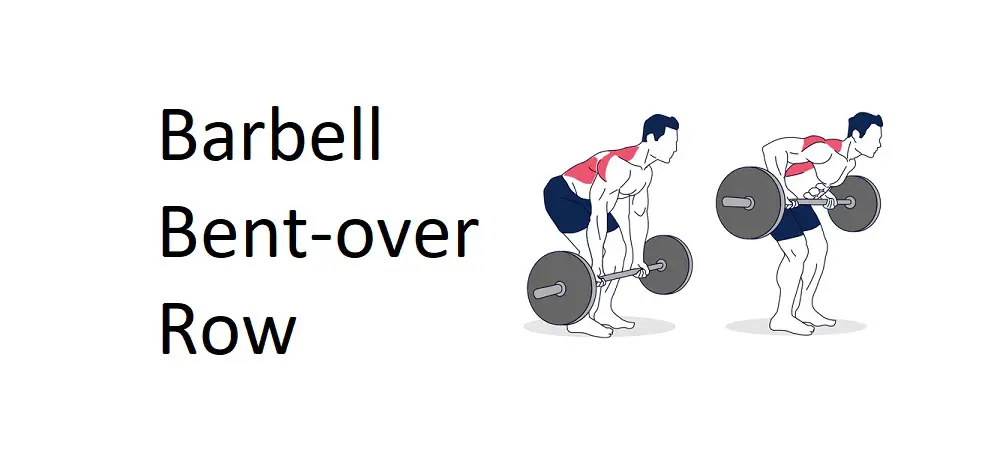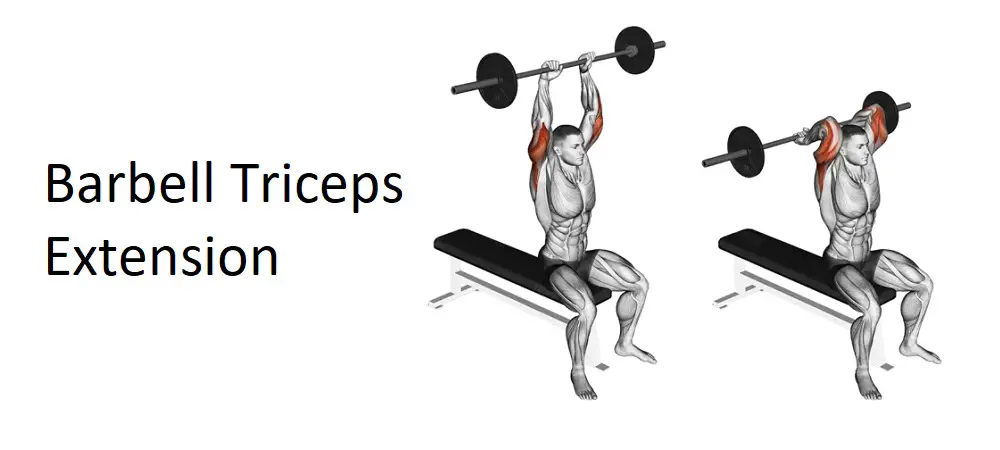Table of Contents
The Barbell Bent-over Row is a compound exercise that targets multiple muscle groups, primarily the muscles of the upper back, including the lats, rhomboids, and traps. In this comprehensive guide, we’ll delve into the correct technique, benefits, variations, and other essential details associated with the Barbell Bent-over Row.
Instructions
Setup:
- Position Yourself: Stand with your feet shoulder-width apart, holding a barbell with an overhand grip (palms facing down). Keep your knees slightly bent and your back straight.
- Bend Forward: Hinge at the hips and lean forward until your torso is approximately parallel to the ground. Ensure that your back remains straight throughout the movement, and avoid rounding your spine.
Execution:
- Pull the Barbell: Exhale as you pull the barbell towards your lower chest or abdomen, retracting your shoulder blades and squeezing your back muscles at the top of the movement.
- Lower the Barbell: Inhale as you slowly lower the barbell back to the starting position, maintaining control over the movement. Keep your back straight and avoid swinging the weight.
- Repeat: Perform the desired number of repetitions, focusing on maintaining proper form and control throughout the exercise.
Benefits
- Upper Back Development: The Barbell Bent-over Row targets the muscles of the upper back, including the latissimus dorsi, rhomboids, and traps, helping to improve overall back strength and muscle definition.
- Compound Movement: As a compound exercise, the Barbell Bent-over Row engages multiple muscle groups simultaneously, making it an efficient choice for building overall upper body strength and muscle mass.
- Improved Posture: Strengthening the muscles of the upper back can help improve posture by promoting proper alignment and reducing the risk of rounded shoulders and kyphosis.
- Functional Strength: The pulling motion of the Barbell Bent-over Row mimics real-life movements such as lifting and carrying, making it a valuable exercise for developing functional strength.
Muscles worked in Barbell Bent-over Row
The Barbell Bent-over Row primarily targets the muscles of the upper back, as well as several other muscle groups. The key muscles worked during this exercise include:
- Latissimus Dorsi (Lats): Located on the sides of the back, the lats are responsible for the primary pulling movement in the Barbell Bent-over Row. They help add width and thickness to the back.
- Rhomboids: These muscles are situated between the shoulder blades and are responsible for retracting the shoulder blades. They help stabilize the scapulae during the rowing movement.
- Trapezius (Traps): The upper and middle fibers of the trapezius help elevate and retract the shoulder blades during the rowing motion. They also provide stability to the upper back.
- Posterior Deltoids: The rear deltoids, located at the back of the shoulders, are activated to a lesser extent during the rowing movement. They assist in shoulder extension.
- Erector Spinae: The erector spinae muscles, which run along the length of the spine, are engaged isometrically to stabilize the spine and maintain proper posture throughout the exercise.
- Biceps Brachii: While not the primary target, the biceps brachii act as dynamic stabilizers during the rowing movement. They assist in elbow flexion as the barbell is pulled towards the body.
- Forearms: The muscles of the forearms, including the brachioradialis and forearm flexors, are engaged to grip and hold onto the barbell securely throughout the exercise.
By targeting these muscles, the Barbell Bent-over Row helps develop overall back strength, muscle size, and definition. It’s important to maintain proper form and technique to effectively engage these muscles and minimize the risk of injury. If you experience any discomfort or pain during the exercise, cease immediately and consult with a fitness professional or healthcare provider.
Alternate names for Barbell Bent-over Row:
- Bent-over Barbell Row
- Barbell Bent Row
- Bent-over Row with Barbell
- Barbell Bent-over Back Row
FAQs
What is a barbell bent-over row?
The barbell bent-over row is a compound strength training exercise that primarily targets the muscles of the back, including the latissimus dorsi, rhomboids, and lower traps. It also engages the biceps and forearms as secondary muscles.
How do you perform a barbell bent-over row?
Start by standing with your feet shoulder-width apart, holding a barbell with an overhand grip (palms facing down) and your hands slightly wider than shoulder-width apart.
Bend your knees slightly and hinge forward at your hips, keeping your back straight and chest up. Your torso should be at approximately a 45-degree angle to the floor.
Pull the barbell towards your lower chest by retracting your shoulder blades and driving your elbows back. Keep the bar close to your body throughout the movement.
Pause briefly at the top of the movement, then lower the barbell back to the starting position with control.
Repeat for the desired number of repetitions.
Which muscles does the barbell bent-over row target?
The barbell bent-over row primarily targets the muscles of the back, including the latissimus dorsi, rhomboids, and lower traps. It also engages the biceps and forearms as secondary muscles.
What equipment is needed for the barbell bent-over row?
You’ll need a barbell and weight plates. Optionally, you may use lifting straps to help grip the barbell if your grip strength is a limiting factor.
What are some tips for proper form?
Keep your back flat and core engaged throughout the exercise to maintain stability and prevent injury.
Focus on pulling the barbell towards your lower chest while keeping your elbows close to your body.
Avoid excessive swinging or momentum by using controlled movements.
Use a weight that allows you to complete the exercise with proper form while still providing a challenge.
How many sets and repetitions should I do?
The number of sets and repetitions can vary depending on your fitness level, goals, and overall workout routine. A common approach is 3-4 sets of 8-12 repetitions.
Is it safe to perform the barbell bent-over row?
When performed with proper form and an appropriate weight, the barbell bent-over row can be safe and effective. However, it’s essential to start with lighter weights to master the technique and gradually progress to heavier weights to avoid injury.
Can the barbell bent-over row help with building muscle and strength?
Yes, the barbell bent-over row is an excellent exercise for building muscle and strength in the back, as well as improving grip strength and overall pulling power.
Are there any variations of the barbell bent-over row?
Yes, there are several variations of the bent-over row, including the underhand grip (supinated grip) bent-over row, single-arm dumbbell row, and T-bar row, each of which targets the muscles of the back in slightly different ways.
Should I feel any discomfort during this exercise?
You may feel some muscular fatigue or discomfort in the muscles being worked, particularly in the upper back and arms. However, you should not experience sharp pain or discomfort in your joints or lower back. If you do, stop the exercise and reassess your form or seek guidance from a fitness professional.
Variations
- Underhand Grip Row: Perform the exercise with an underhand grip (palms facing up) to emphasize the biceps and lower lats.
- Wide Grip Row: Use a wider grip on the barbell to target the outer portion of the back and increase overall muscle activation.
- Single-arm Row: Perform the exercise one arm at a time to address any muscular imbalances and engage the core for stabilization.
Conclusion
Incorporating the Barbell Bent-over Row into your workout routine can help you build a strong and well-developed upper back. By mastering the proper technique and gradually increasing the weight over time, you can experience significant improvements in back strength, muscle size, and overall upper body performance. Remember to warm up properly before performing heavy compound exercises and to listen to your body to prevent injury. If you’re new to weightlifting or have any existing injuries or medical conditions, consult with a fitness professional or healthcare provider before attempting the Barbell Bent-over Row.
Also, check the Barbell Rear Delt Row
You can also check the research on Comparison of Different Rowing Exercises








